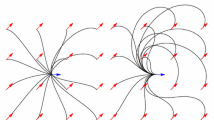Abstract
An optimal algorithm for the reconstruction of a surface from its shading image is presented. The algorithm solves the 3D reconstruction from a single shading image problem. The shading image is treated as a penalty function and the height of the reconstructed surface is a weighted distance. A consistent numerical scheme based on Sethian's fast marching method is used to compute the reconstructed surface. The surface is a viscosity solution of an Eikonal equation for the vertical light source case. For the oblique light source case, the reconstructed surface is the viscosity solution to a different partial differential equation. A modification of the fast marching method yields a numerically consistent, computationally optimal, and practically fast algorithm for the classical shape from shading problem. Next, the fast marching method coupled with a back tracking via gradient descent along the reconstructed surface is shown to solve the path planning problem in robot navigation.
Similar content being viewed by others
References
M. Bichsel and A.P. Pentland, “A simple algorithm for shape from shading,” in Proceedings IEEECVPR, Champaign, Illinois, May 1992, pp. 459–465.
M.J. Brooks and W. Chojnacki, “Direct computation of shape from shading,” in Proc. of ICPR, Int. Conf. of Pattern Recognition, Israel, October 1994, pp. 114–119.
A.M. Bruckstein, “On shape from shading,” Comput. Vision Graphics Image Process., Vol. 44, pp. 139–154, 1988.
L. Cohen and R. Kimmel, “Global minimum for active contours models: A minimal path approach,” Int. J. of Comp. Vision, Vol. 24, No. 1, pp. 57–78, 1997.
M.G. Crandall, H. Ishii, and P.L. Lions, “User's guide to viscosity solutions of second order partial linear differential equations,” Bulletin of the American Math. Society, Vol. 27, pp. 1–67, 1992.
T. Deschamps and L.D. Cohen, “Minimal paths in 3D images and application to virtual endoscopy,” in Proc. of 6th ECCV, Dublin, Ireland, June 2000.
E.W. Dijkstra, “A note on two problems in connection with graphs,” Numerische Mathematic, Vol. 1, pp. 269–271, 1959.
P. Dupuis and J. Oliensis, “An optimal control formulation and related numerical methods for a problem in shape reconstruction,” Ann. Appl. Probab., Vol. 4, No. 2, pp. 287–346, 1994.
J. Gil and R. Kimmel, “Efficient dilation, erosion, opening and closing algorithms,” in Proc. of. Int. Symposium on Mathematical Morphology V, Palo-Alto, June, 2000.
B.K.P. Horn, “Obtaining shape from shading information,” in The Psychology of Computer Vision, P.H Winston (Ed.), Mc-Graw Hill, 1975 pp. 115–155.
B.K.P. Horn, “Height and gradient from shading,” Int. J. of Comp. Vision, Vol. 5, pp. 37–75, 1990.
B.K.P. Horn and M.J. Brooks (Eds.), Shape from Shading, MIT Press: Cambridge, MA, 1989.
O. Khatib, “Real-time obstacle avoidance for manipulators and mobile robots,” The International Journal of Robotics Research, Vol. 5, No. 1, pp. 396–404, 1986.
R. Kimmel, A. Amir, and A.M. Bruckstein, “Finding shortest paths on surfaces using level sets propagation,” IEEE Trans. on PAMI, Vol. 17, No. 1, pp. 635–640, 1995.
R. Kimmel and A.M. Bruckstein, “Shape from shading via level sets,” Technion—Israel Institute of Technology, Israel, CIS Report, #9209, June 1992.
R. Kimmel and A.M. Bruckstein, “Global shape from shading,” CVIU, Vol. 62, No. 3, pp. 360–369, 1995.
R. Kimmel and A.M. Bruckstein, “Tracking level sets by level sets: A method for solving the shape from shading problem,” CVIU, Vol. 62, No. 2, pp. 47–58, 1995.
R. Kimmel and J.A. Sethian, “Computing geodesic paths on manifolds,” Proceedings of National Academy of Sciences, USA, Vol. 95, No. 15, pp. 8431–8435, 1998.
R. Kimmel and J.A. Sethian, “Fast Voronoi diagrams and offsets on triangulated surfaces,” in Curves and Surfaces, A.K Peters, Ltd. Wellesley, MA, 1999.
J.C. Latombe, Robot Motion Planning, Kluwer Academic Publishers: Boston, MA, 1991.
C.H. Lee and A. Rosenfeld, “Improved methods of estimating shape from shading using the light source coordinate system,” Artificial Intelligence, Vol. 26, No. 1, pp. 125–143, 1985.
P.L. Lions, E. Rouy, and A. Tourin, “Shape-from-shading, viscosity solutions and edges,” Numerische Mathematik, Vol. 64, pp. 323–353, 1993.
R. Malladi and J.A. Sethian, “An O(Nlog (N)) algorithm for shape modeling,” Proc. of National Academy of Sciences, USA, Vol. 93, pp. 9389–9392, 1996.
E. Rouy and A. Tourin, “Aviscosity solutions approach to shape-from-shading,” SIAM, J. Numer. Analy., Vol. 29. No. 3, pp. 867–884, 1992.
R. Sedgewick, Algorithms, Addison-Wesley, Boston, MA, 1988.
J.A. Sethian, Level Set Methods: Evolving Interfaces in Geometry, Fluid Mechanics, Computer Vision and Materials Sciences, Cambridge Univ. Press, 1996.
J.A. Sethian, “A marching level set method for monotonically advancing fronts,” Proc. Nat. Acad. Sci., Vol. 93, No. 4, 1996.
J.A. Sethian, “Fast marching methods,” SIAM Review, Vol. 41, pp. 199–235, 1999.
J.N. Tsitsiklis, “Efficient algorithms for globally optimal trajectories,” IEEE Trans. on Automatic Control, Vol. 40, No. 9, pp. 1528–1538, 1995.
P.W. Verbeek and B.J.H. Verwer, “Shading from shape, the eikonal equation solved by gray-weighted distance transform,” Pattern. Rec. Letters, Vol. 11, pp. 681–690, 1990.
Author information
Authors and Affiliations
Rights and permissions
About this article
Cite this article
Kimmel, R., Sethian, J.A. Optimal Algorithm for Shape from Shading and Path Planning. Journal of Mathematical Imaging and Vision 14, 237–244 (2001). https://doi.org/10.1023/A:1011234012449
Issue Date:
DOI: https://doi.org/10.1023/A:1011234012449




